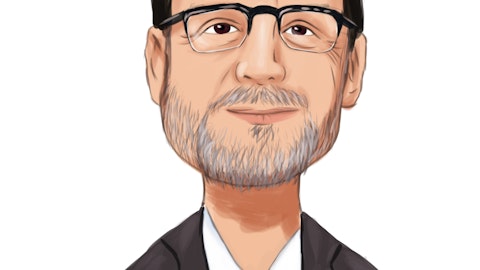Community Bank System, Inc. (NYSE:CBU) Q1 2023 Earnings Call Transcript April 25, 2023
Community Bank System, Inc. misses on earnings expectations. Reported EPS is $0.11 EPS, expectations were $0.91.
Operator: Welcome to the Community Bank System First Quarter 2023 Earnings Conference Call. Please note that this presentation contains forward-looking statements within the provisions of the Private Securities Litigation Reform Act of 1995 that are based on current expectations, estimates, and projections about the industry, markets, and economic environment in which the company operates. Such statements involve risks and uncertainties that could cause actual results to differ materially from the results discussed in these statements. These risks are detailed in the company’s annual report and Form 10-K filed with the Securities and Exchange Commission. Please note this conference is being recorded. Today’s call presenters are Mark Tryniski, President and Chief Executive Officer; and Joseph Sutaris, Executive Vice President and Chief Financial Officer.
They will be joined by Dimitar Karaivanov, Executive Vice President and Chief Operating Officer, for the question-and-answer session. Gentlemen, you may begin.
Mark Tryniski: Thank you. Good morning, everyone, and thank you for joining our first quarter conference call. certainly, has been an eventful quarter for the industry. I typically comment on earnings first, but it feels like I should start with the balance sheet. First off, the events of the weekend of March 10 had virtually no impact on us beyond the minimal level of customer inquiries. We proactively reached out to our larger consumer commercial and municipal customers with no movement at all in those deposits or relationships. Total deposits were actually up almost $100 million during the quarter, mostly CDs, with the mix otherwise being remarkably consistent. Our uninsured deposits are 17% of total deposits, and our average consumer and commercial account balances are 12,000 and $60,000, respectively.
We have no broker or wholesale deposits of any kind. We did need to move rates in the quarter, which raised our deposit funding costs up to 31 basis points. And as of the end of March, our full cycle deposit beta is 5%. Joe will speak further on this topic, but we have $4.7 billion of immediately available liquidity. Loan growth in the quarter was solid at $173 million, mostly business and auto lending, and asset quality remains exceptional. Earnings for the quarter were lower than we expected due mainly to expenses and the elimination of some retail fees, both of which Joe will discuss further. But year-over-year, we delivered greater net interest income and record revenues from our nonbanking businesses, which continued to grow despite capital market conditions.
Looking ahead, we think our funding and liquidity are really well positioned, and we have another $350 million of treasury securities maturing next month that will be additive to margin and earnings. We have one of the best deposit bases of any bank in the U.S. Our lending businesses are all executing really well, and we expect that to continue. Credit quality remains exceptional and our lending portfolios are highly diversified and highly granular, and our nonbanking businesses continued to grow despite market conditions. So, I think we are extremely well positioned for the future and expect our formats to reflect that regardless of the operating environment. Joe?
Joseph Sutaris: Thank you, Mark, and good morning, everyone. As Mark noted, fully diluted GAAP earnings per share were $0.11 in the quarter. This compares to a fully diluted GAAP earnings per share of $0.86 in the first quarter of ’22 and $0.97 in the linked fourth quarter of 2022. During the company strategically repositioned its balance sheet by selling available-for-sale investment securities with a market value of $733.8 million, the proceeds of which were used to pay down expensive overnight borrowings to provide the company with greater flexibility to manage balance sheet growth and deposit funding. In connection with the repositioning the company recognized a pretax realized loss on sale of $52.3 million, resulting in a $0.75 per share after-tax loss on the sale.
Excluding the loss on the sale of investment securities, acquisition-related expenses and gain on debt extinguishment, the company’s fully diluted operating earnings per share for the quarter was $0.86. This compares to $0.87 of fully diluted operating earnings per share in the first quarter of 2022 and $0.96 in the linked fourth quarter. The $0.01 decrease in operating earnings per share on a year-over-year basis was driven by a decrease in banking-related noninterest revenues, an increase in the provision for credit losses and higher operating expenses, partially offset by increases in net interest income, and financial services business revenues and decreases in income taxes and fully diluted shares outstanding. $0.1 per share decrease in operating earnings per share on a linked quarter basis was largely driven by an increase in operating expenses and lower deposit service fees.
First quarter 2023 adjusted pretax pre-provision net revenue per share, which is a non-GAAP measure as defined in our earnings release of $1.16 was up $0.04 as compared to the first quarter of 2022 and down $0.13 compared to fourth quarter of 2022. The company recorded total revenues of $124.5 million in the first quarter of 2023, a decrease of $36 million or 22.4% from the prior year’s first quarter. The decrease in total revenues between the periods was primarily driven by the previously mentioned loss on sale of during the quarter. Total operating revenues, which excludes net realized and unrealized securities gains and losses, and gain on debt extinguishment, were $176.6 million in the first quarter of 2023, an increase of $16.1 million or 10% from the prior year’s first quarter, driven primarily by an increase in net interest income.
Comparatively, total revenues were down $51.4 million or 29.2% from the fourth quarter of 2022 results, but up $0.7 million or 0.4% on an operating basis. The company reported net interest income of $111 million in the first quarter of 2023. This was up $16.2 million or 17% over the prior year’s first quarter. The company’s tax equivalent net interest margin increased by 47 basis points from 2.73% in the first quarter of 2022 to 3.20% in the first quarter of 2023. The tax filing yield on average interest-earning assets was up 82 basis points over the prior year’s first quarter, while the average cost of funds increased 35 basis points over the same period. Comparatively, the company’s net interest margin increased 18 basis points on a linked quarter basis, while net interest income decreased $1.2 million due in part to a lower day count in the quarter.

Excluding the impact of a loss on sold investment securities and the gain on debt extinguishment, noninterest revenues decreased $0.1 million between the comparable annual quarters, a $1.1 million increase in insured services revenues in the quarter offset by a $0.6 million decrease in banking-related revenues, a $0.2 million decrease in employee benefit services revenues and a $0.4 million decrease in wealth management revenues. The decrease in banking-related noninsurance revenues was driven by a decrease in debit interchange revenues and overdraft occurrences as well as the recent implementation of certain deposit fee changes, including the elimination of non-sufficient funds and available fund fees. Despite the organic growth in the employee benefits services in the place search business, excuse me, and Wealth Management businesses, revenues were down due to market-related headwinds.
On a linked-quarter basis, noninterest revenues, excluding the loss on the sale of securities and gain on debt extinguishment increased $1.9 million or 2.9%. And an increase in revenues in all three of the financial services businesses totaling $4.4 million or 10% was partially offset by a $2.6 million or 13.6% decrease in banking-related noninterest revenues. During the first quarter of 2023, the company recorded a provision for credit losses of $3.5 million, driven by a weaker economic forecast combined with $172.9 million increase in outstanding. Comparatively, the company recorded a provision for credit losses of $0.9 million during the first quarter of 2022 and $2.8 million in the fourth quarter of 2022. The company reported $114 million in total operating expenses in the first quarter of 2023 compared to $99.8 million in total operating expenses prior year’s first quarter.
The $14.2 million increase in operating expenses was primarily attributable to a $9.8 million increase in salaries and employee benefits and a $4.2 million increase in other expenses. The increase in salaries and employee benefits expense was driven by increases in merit, severance, and incentive-related employee wages, including minimal wage-related compression on the lower end of the company’s PayScale, acquisition-related and other additions is happening, higher payroll taxes and higher employee benefit-related expenses. Other expenses were up due to an increase in insurance costs, including larger FDIC insurance expenses higher professional fees, business development travel, and marketing expenses, along with incremental expenses associated with operating an expanded franchise subsequent to the Elmira acquisition in the second quarter of 2022.
In comparison, the company reported $105.9 million of total operating expenses in the fourth quarter of 2022, an $8.2 million or 7.7% increase in total operating expenses between the fourth quarter of ’22 and the first quarter of 2023 was largely attributable to a $7.4 million 11.5% increase in salaries and employee benefits $0.7 million, or 5% increase in other expenses. For the remaining three quarters of 2023, management anticipates that total operating expenses, excluding any future acquisition activities, will remain generally in line with first quarter levels. Set another way on a full year — full calendar year-over-year basis, the company anticipates total operating expenses to increase between 5% and 9%. The effective tax rate for the first quarter of 2023 was 16.9%, down from 21.4% in the first quarter of 2022.
excluding the impact of tax benefits related to stock-based compensation activity. The effective tax rate was 21.4% in the first quarter of 2023, down from 22.3% in the first quarter of 2022. The company’s total assets were $15.26 billion at March 31, 2023, representing a $369.9 million or 2.4% decrease from one year prior and a $579.7 million or $3.7 million decrease from the end of the fourth quarter of 2022. The book value of average interest-earning assets decreased $662.1 million or 4.5% during the first quarter due primarily to a decrease in the average book value of the investment securities, partially offset by higher average loan balances. At the end of the quarter, the book value of interest-earning assets was $14.03 billion, comprised of $8.90 billion of loans, $5.02 billion investment securities, and $28 million of cash equivalents.
Ending loans increased $1.56 billion or 21% over the prior year and $172.9 million or 2% during the quarter. The increase in ending loans year-over-year was driven by increases in all loan categories due to net organic growth in the Elmira acquisition. Increased loans outstanding on a linked quarter basis was driven by a $102.3 million or 2.8% increase in business lending at $70.7 million, a 1.4% net increase in the company’s consumer loan portfolios. The company’s liquidity position remains strong. The company’s funding base is largely comprised of core noninterest-bearing demand deposit accounts and interest-bearing checking, savings, and money market public accounts with customers that operate reside, or work within our branch footprint.
At March 31, 2023, the company’s readily available source of liquidity totaled $4.69 billion, including cash and cash equivalent balances net of float of $109.7 million, $1.54 billion of funding availability at the Federal Reserve Bank discount window, $1.84 billion of unused borrowing capacity at the Federal Home Loan Bank of New York and $1.2 billion of unpledged investment securities that could be pledged as collateral for additional borrowing capacity. These sources of immediately available liquidity represent over 200% of the company’s noninsured deposits and net of collateralized deposits, which are estimated at $2.3 billion. The company’s ending total loans were up $98 million from the end of the fourth quarter or approximately 1%. And deposit base is well diversified across customer segments comprised of approximately 63% consumer balances, 25% business balances, and 12% municipal balances and broadly dispersed with average consumer deposit account balance of $12,000 in average business deposit relationship of approximately $60,000.
The company’s cycle-to-date deposit beta is 5%, reflective of a high proportion of noninterest-bearing deposits, which represent 30% — over 30% of total deposits and composition and stability of the customer base, while the cycle-to-date total funding beta, 7%. At the end of the quarter, 74% of the company’s total deposit balances were in checking and savings accounts and the weighted average age of the company’s non-maturity deposit accounts is approximately 15 years. The company does not currently have any brokered or wholesale deposits on its balance sheet. The company’s loan-to-deposit ratio at the end of the first quarter was 68.5%, providing future opportunity to migrate lower-yielding investment security balances into higher-yielding loans.
In addition, during the remaining three quarters of 2023, the company anticipates receiving over $600 million of investment security crystal cash flows to support its funding needs. At March 31, 2023, all the companies and the bank’s regulatory capital ratio significantly exceeded well-capitalized standards. More specifically, the company’s Tier 1 leverage ratio was 9.06% on March 31, 2023, with substantially exceeds the regulatory well-capitalized standard of 5%. The company’s net tangible equity to net tangible assets ratio was 5.41% on March 31, 2023, up 77 basis points from the end of the fourth quarter of 2022. During the first quarter, the company repurchased 200,000 shares of its common stock pursuant to its port-approved 2023 free stock repurchase program.
And, March 31, 2023, the company’s allowance for credit losses totaled $63.2 million from 0.70% of total loans outstanding. This compares to $61.1 million or 0.69% of total loans outstanding at the end of the fourth quarter of 2022 and $50.1 million or 0.68% of total loans outstanding at March 31, 2022. During the first quarter of 2023, the company reported net charge-offs of $1.5 million or 7 basis points of average annual loans annualized. This compares to 3 basis points of annualized net charge-offs in the first quarter of 2022 and 9 basis points in the quarter of 2022. At March 31, 2023, nonperforming loans totaled $33.8 million or 0.38% of total loans outstanding, loans 30 to 89 days for delinquent or 0.35% of total loans outstanding at March 31, 2023, down from 0.51% at the end of the fourth quarter of 2022.
We believe the company’s strong liquidity profile, capital reserves, core deposit base, asset quality, and revenue profile provide a solid foundation for future opportunities. Looking forward, we are encouraged by the momentum in our business. The company continued to organically grow its loan portfolios and asset quality remains strong. The company’s granular Main Street focused deposit base and strong liquidity profile are expected to support future growth in our banking business. In addition, new business opportunities in the financial services businesses remained strong. Thank you. I will now turn it back to Daniel to open the line for questions.
See also 15 Best Retirement Communities For Active Adults and 25 Countries with the Best Hospitals in the World.
Q&A Session
Follow Community Bank System Inc. (NYSE:CBU)
Follow Community Bank System Inc. (NYSE:CBU)
Operator: . The first question comes from Alex Twerdahl from Piper Sandler. Please go ahead.
Alex Twerdahl: Good morning. First off, can you just elaborate a little bit on what you did with the NSF fee this quarter and whether or not that $16.2 million is the right run rate for deposit service fees over the remainder of the year?
Joseph Sutaris: Yes. So late in the fourth quarter and also, I guess, really kicking in, in the early part of the first quarter. We made some changes, particularly on NSF and unavailable fund fees. Our expectation on a full-year basis is that we’ll effectively reduce overall deposit service fees by $6 million to $8 million. Also, in the first quarter, Alex, we just have lower occurrences of overdraft fast, and just typically deposit service fees are down a bit in the first quarter as compared to the fourth quarter. So, that run rate that we have in the first quarter is potentially just slightly below expectations for the next three quarters because typically, the first quarter is a little bit slower in terms of debit interchange and overdraft occurrences. But on an annualized run rate basis, we expect the changes will effectively reduce fees by $6 million to $8 million.
Alex Twerdahl: Okay. Thank you. And then can you give us a little bit — you said $600 million of cash flows from the securities portfolio over the course of the year. I think Mark mentioned $350 in May. Can you give us the timing of the remainder of that as well as expectations for deposits? I know municipal deposits tend to come in the first quarter, how much we expect to flow out in the second quarter and whether or not — what your kind of seeing underlying there that maybe just to give us a little bit more expectations for overall liquidity management over the next couple of quarters?
Joseph Sutaris: Yes. So, the $350 million, as Mark mentioned, matures in the middle of May. So, we do expect that, that’s a treasury security, so it’s going to happen. We have another $150 million in mid-August, also treasury security. Those two pieces comprise the lion’s share of the $600 million, the other, call it cash flows come out happen throughout the year, basically mortgage-backed security principal repayments. On a blended basis, those two treasury securities are coming off at about a 2.5% yield. So, we do expect to be able to redeploy those proceeds to either pay off overnight borrowings. Should we see some drift down in the deposit base or potentially that could be redeployed into long growth if that opportunity is there?
So, we do expect some, call it, NII pickup net interest income pickup on maturities, Alex. With respect to deposit flows, we typically do see an increase in municipal flows in the first quarter. As we talked about tax collection cycles in New York State, that typically is a couple of hundred million dollars on a net basis in the quarter, and we do typically see those flow out. throughout most of the second quarter. And then we kind of sometimes trip down a bit in the third quarter. Another $100 million or so, and then tax collection occurs in September again for the — districts, and we see kind of a lot of that restore in going into the late part of the third quarter and into the fourth quarter. With respect to IPC deposits, I think we’re just sort of seeing the results of kind of the overall M2 supply, which are reflective of the M2 money supply going down.
And I think the entire industry is seeing flow out of the deposit balances. And I think that’s kind of what we’ll probably have across the industry and potentially to us as well.
Alex Twerdahl: Great. Thanks for taking my question.
Operator: The next question comes from Steve Moss of Raymond James. Please go ahead.
Steve Moss: Good morning. Maybe just starting on loan pricing here and loan growth, good loan growth in the quarter. Just curious what are the yields you’re seeing these days? And let’s just start there.
Dimitar Karaivanov: So, Steve, it’s Dimitar. In the first quarter, we blended to about 6.3% yield on originations. I think if you look at — by various buckets, as we sit here today, commercial is kind of in the mid-to high 6s in the auto business were 7% right now. In mortgage, obviously, it depends on what happens with aggregate rates but that has been kind of in the 6% to 6.5% range. So, we have not seen much movement. I think in the second quarter so far, with that said, there were a couple of interest rate but one hike in the first quarter that we didn’t get the full benefit of because it was at the end of March, and potentially a lot of hike next week. So, some of the loans that we have tied to Prime should drift up. So — but kind of that range 6s, I think, is a decent proxy for Q2.
Steve Moss: Okay. That’s helpful, Dimitar. And then in terms of just the margin, you have a lot of balance sheet movement here during the current quarter and obviously, upcoming with the treasuries maturing. Just kind of curious, maybe you have a spot margin at quarter end, and kind of how you’re thinking about margin trends for the second and third quarters?
Joseph Sutaris: So, we actually, Steve, the month of March was our highest net interest income our existing month on record. So, we kind of saw a peak NII at the end of the quarter. So, if you think about the catalysts for NII for the balance of 2023. And really, if you look at kind of the second quarter because it’s a little bit difficult to make the call relative to the third and fourth quarter because of the potential funding costs. But if you look at the next quarter, we had the securities maturity of $350 million, which that’s maturing at about $240 million. So that’s going to be led in titer loans or to pay off overnight borrowings. We have a couple of extra days of interest-earning days in Q2, which is helpful as well.
We also have all replacements, right? So, we have about $350 million that’s maturing. And if that’s just replace it, we don’t simply we don’t grow we just replace what’s coming off. We’re picking up about 175 basis points on the replacement yields. So that’s a catalyst for NII. As Dimitar mentioned, we also have an increase in prime that really didn’t catch, if you will, in the first quarter, which we’ll see that in the second quarter. In the next 90 days or so, we have about $850 million of loans that are going to reprice. There’s another roughly $1 billion beyond that. The balance of the first 90 days, there’s about $850 million that’s going to reprice. So that’s helpful. And then, of course, there’s potential for additional loan growth in the quarter.
So, this catalyst on the interest income side, obviously, the question around the cost of funds and cost of deposits remains to be seen. And I would just say that we do have a really strong core deposit franchise. But the rate increases were so rapid in 2022, there’s going to be some necessary increases in funding costs in 2023 as we sort of catch up to some of the changes that were made on prime and Fed funds and the short end of the curve. So, I think there’s going to be a little bit of catch-up. In other words, I don’t believe that our deposit beta will stay at 5% for the full cycle, it’s simply going to accelerate. And I think it has. And I think the whole industry has seen that happen in the last couple of quarters.
Steve Moss: Right. Okay. That’s helpful. And then just on expenses here. Just on the drivers of the increase in compensation expense here. I hear you guys on the full year, relatively stable versus this bounce. Maybe just a little bit of color. I’m not sure if I missed it. Thanks.





